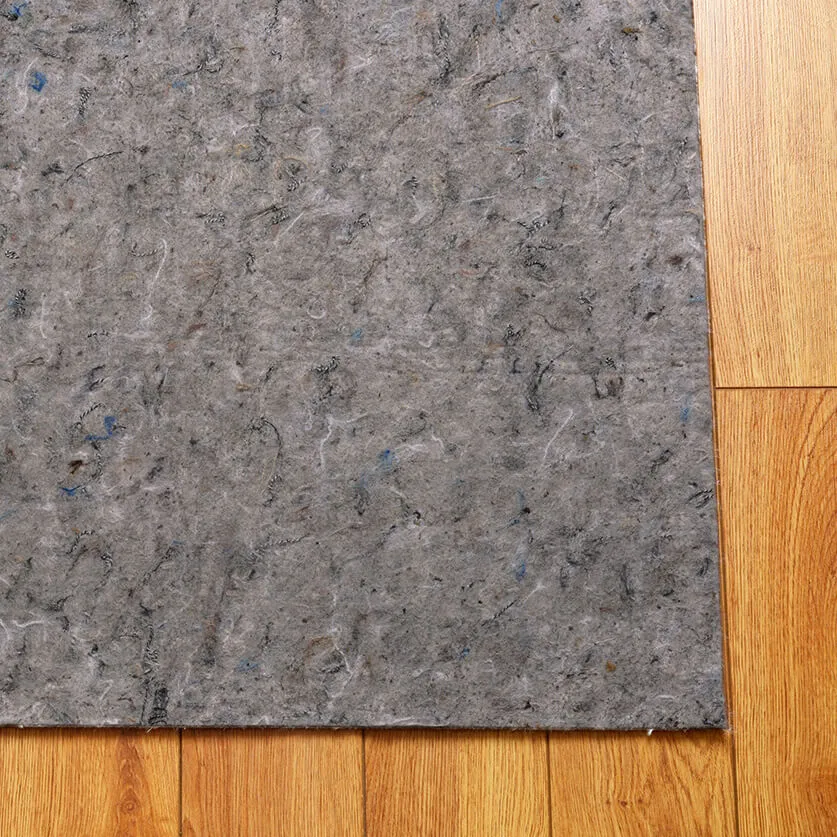AREA RUGS
Area rugs are the finishing touch to any room, adding style, color, and texture.
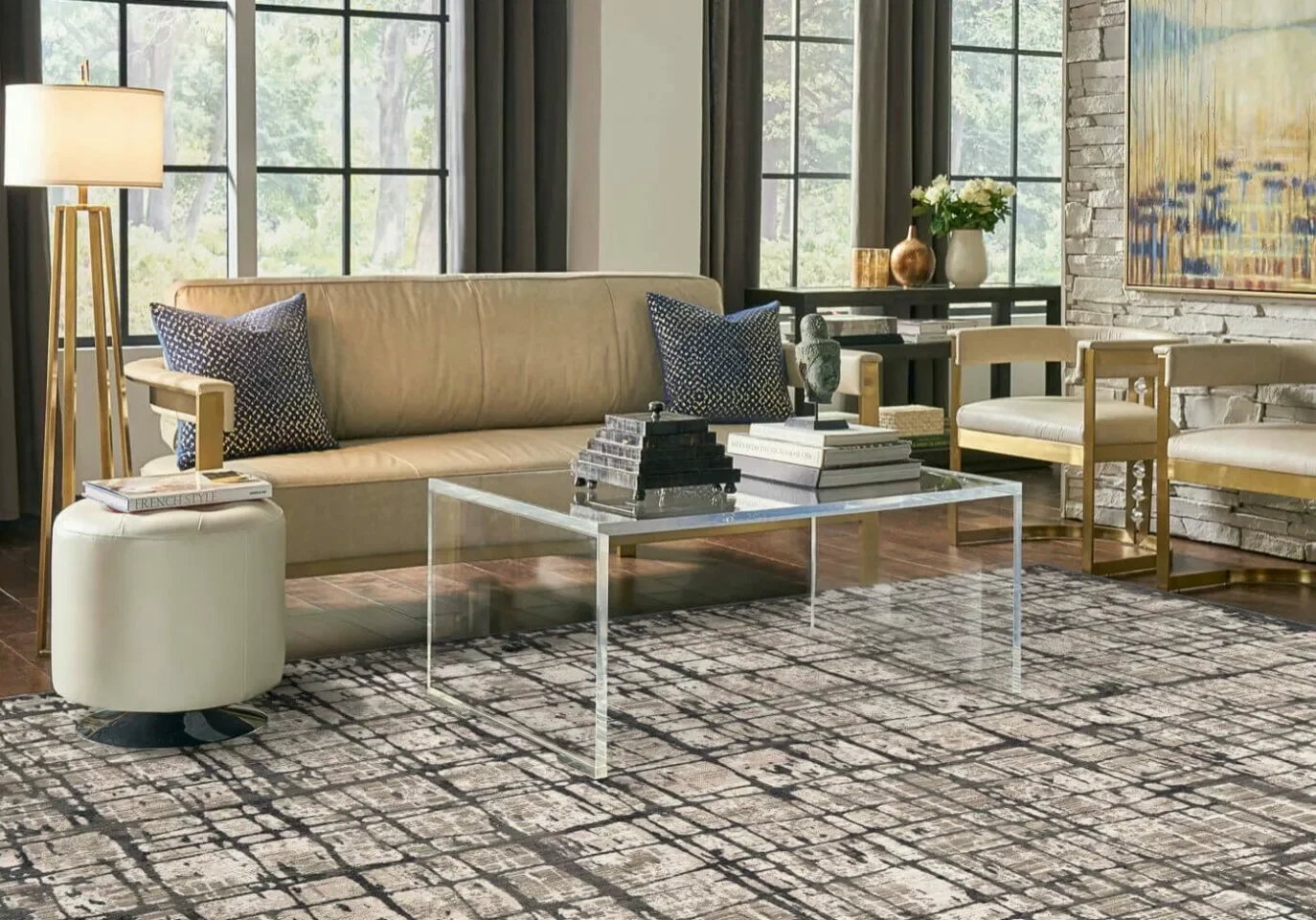
Quality Area Rugs For New Homes
Area rugs help set the tone for each room. Since they are available in a wide variety of colors, patterns, designs, textures, materials, shapes, and sizes, you can create the look you want with ease. Area rugs tie together the colors and textures in your room and can serve as a focal point or a background element. Plus, they help protect hard surface floors and add comfort underfoot.
At The L&L Company, we carry quality area rugs from the top manufacturers to provide you with the latest designs and best products currently available.
We are the preferred area rug provider for builders in the Mid-Atlantic, and we look forward to working with you to create the perfect space for you.
Why Choose Area Rugs?
Area rugs are not only a beautiful addition to hard surface flooring, but they provide comfort, warmth, and softness underfoot. They also add a layer of protection to hard surface floors, increasing the longevity of your flooring. Area rugs reduce the amount of wear and tear on your floors, as well as reduce the risk of scratching, fading, and stains.
Area rugs are easy to replace with each season or to refresh a space. You will love the way our area rugs look in your rooms.
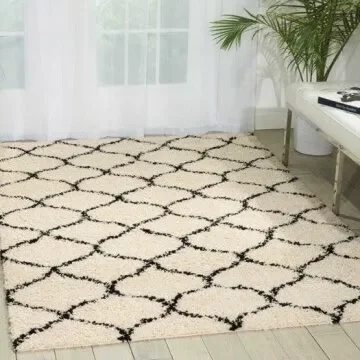
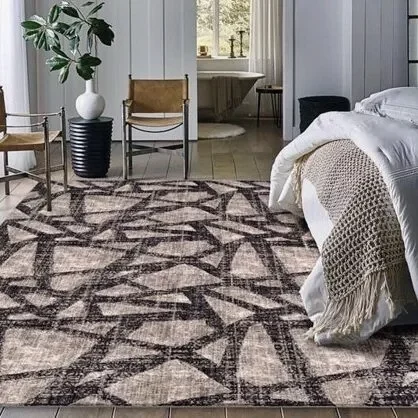
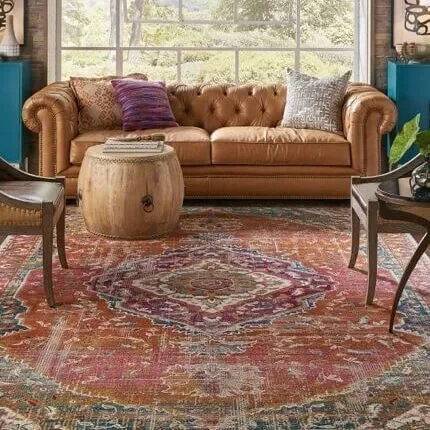
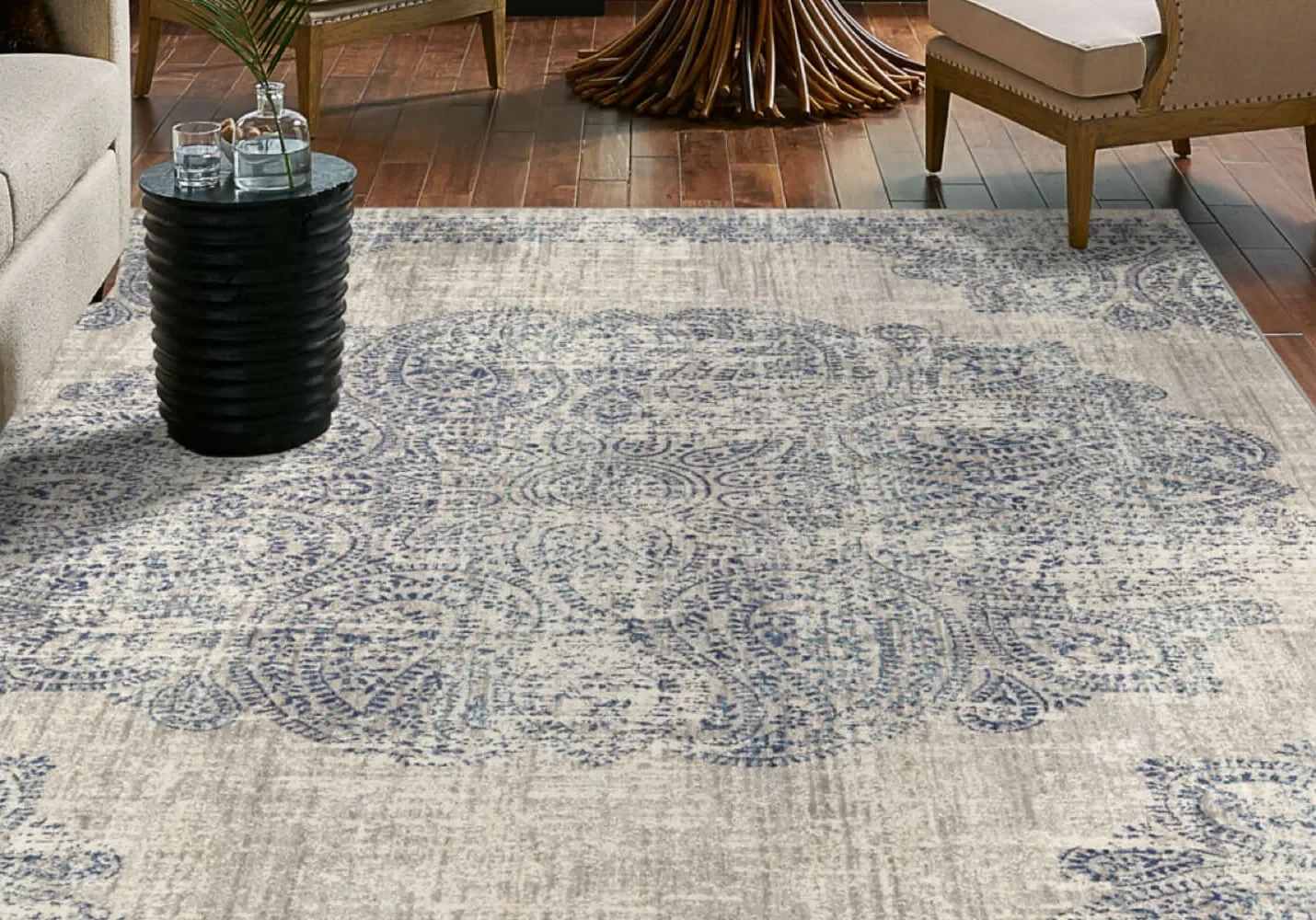
Need Inspiration?
View our area rug gallery to see the latest trends and inspiration for your homes.
Learn More About Area Rugs
Before you Buy
Know these things before you purchase an area rug.
We want you to know. It’s as simple and important as that. Important because your goal here is to find and purchase products that will impact your home and home life.
We take that very seriously.
If we’ve met our goal of providing you with area rug knowledge, hopefully you’re becoming a lot wiser shopper with a clearer picture of this flooring category.
But there remain a number of specific things you should know and understand about area rugs before you get into the buying phase.
So, before you buy, browse through this section for suggestions and considerations about area rugs before you enter the area of purchasing.
Being aware of and understanding some of the ins and outs of rugs can only make you a more educated shopper, and increase your confidence in your final decision.
We’ll cover area rugs in general first, and then end on antique handmade rugs.
5 steps to laying down the ideal area rug.
There are five important elements to think about prior to purchasing an area rug.
1. Size and shape: elementary but essential information.
Area rugs are made in different sizes and in different shapes.
The most common sizes are 2’x3’, 4’x6’, 5’x8’, 6’x9’, 8’x10’ and up.
Shapes are rectangle, round, square, oval, octagon or runners.
You should know that most handmade rugs are rectangular and have standard sizes.
As a general rule, choosing the correct size area rug depends on the dimensions of the room or space you are trying to cover.
Follow these guidelines to determine what size rug will best suit your needs:
- Measure the size of your room. (Measure twice to be sure.)
- Measure the space you want covered. (Follow advice in first bullet.)
- Now place a piece of paper where each of the corners will fall; adjust the “corners” as needed to make the space larger or smaller and then re-measure the area. Be patient and careful.
- If you want to cover the majority of the room, be sure to leave a 12”-15” border of flooring exposed to set off your area rug.
- If you are placing an area rug under your dining room table, select a rug that is large enough so that when seated at the table the back legs of the chairs are on the rug with enough space to push back and get up from the table.
2. Color: whether muted or vibrant, it’s a key factor.
Color is one of the most vital elements of an area rug, whether its machine made or handmade.
The right combination of colors, expressed through the right design, becomes more than an area rug, it becomes a work or art. Your art.
Select a rug with colors that will visually enhance your room’s décor.
The colors don’t have to match the other colors in the room perfectly.
Some of the best interior designs feature new and interesting combinations of colors that either contrast or compliment a room’s color scheme.
So feel free to express yourself – think outside the box (room).
Colors are also an important factor in determining the origin of many handmade rugs.
Different rug producing areas use different combinations of colors and different types of dyes.
3. Pattern: it can help you form an opinion.
Pattern is one of the most helpful elements in narrowing down rug selection, especially after size and color.
We define pattern as the way lines are used to form shapes on a rug.
In the rug industry, pattern is divided into three categories: curvilinear, geometric, and pictorial.
The first two refer to rugs with conventional motifs that are woven with curving lines (curvilinear) or straight lines (geometric).
The third (a much smaller group) refers to rugs that portray people and/or animals.
4. Style: the goal is to find one that matches yours.
Style can be defined as the way different motifs, colors and patterns give character to a rug.
Styles range from floral to contemporary to traditional. They can also reflect a season, or a theme (nautical, birds, water). Roll out your favorite!
The most important styles of handmade rugs that have existed, or still do exist in various parts of the world, include: Persian, Chinese, Turkoman, Caucasian, European, Anatolian, Tibetan, Indian, Baluchi, North African, Native American, and East Turkestan.
In addition, many of these styles have sub-styles.
For example, Tabriz is a sub-style of the Persian style.
Many styles or sub-styles are made in their place of origin as well as in other countries or areas.
Consider that a Tabriz style rug may be made in Tabriz but it could also be made in India. If you must know, ask your retailer.
5. Design: yours will probably be one of three.
All rugs can be divided into three major designs:
• All-over, in which motifs are spread throughout the rug.
• Medallion, where a large centerpiece is the focal point of the design.
• One-sided, in which the design is woven in one direction.
Additionally, designs can be intricate or simple, solid, or feature borders.
Buying an antique handmade rug? This advice is ageless, unconditional.
If a Persian, Oriental or any other antique handmade rug is the solution for the way you live, consider these two attributes carefully.
1. Age: with antique rugs, time will tell.
The age attribute specifies how old a rug is.
There are three major timeline categories:
• Antique, over 60 years old.
• Semi-antique, between 25 and 60 years old.
• Contemporary, less than 25 years old.
2. Condition: what shape it’s in can shape your rug’s value.
Handmade rugs are classified according to these overall conditions:
• Fine, a rug in excellent shape with no stains, tears or holes, and no previous repair work.
• Average, a rug that may have undergone or may require some minor repair.
• Worn, a rug which may have discoloration, fading, insect or foundation damage.
Worn rugs should not be dismissed because, similar to fine and average rugs, they can still have a very good resale value.
Some are even considered valuable antiques. So shop carefully.
Finally, be calculating! Figure the total cost of rug ownership.
The price on the tag of the rug you’re buying is just one component of your cost.
To ensure there are no surprises, and the rug you select fits within your budget, be sure to ask your retailer to calculate the total cost of your floor covering project.
Here’s a list of potential additional expenses you may incur:
- Product delivery. Delivering your rug and installation materials (padding) to your home may or may not be included in the price you’re quoted.
- Financing. Many retailers offer financing; financing is not an additional cost but rather an option of payment.
- Don’t forget to ask the retailer and consult the manufacturer’s warranty and care guide for directions on how frequently your rug should be cleaned and the cost to clean it.
There’s a lot to know and consider before buying your new area rug but it’s well worth the effort.
Area rugs add beauty and style, charm and elegance, personality and pride to any home.
We hope this section adds more knowledge, understanding and practicality to your shopping experience.
How it's Made
A review of how area rugs are made.
The art of making rugs by hand spans time, geography and cultures. The process of manufacturing rugs, while recent, has revolutionized the area rug industry. To understand both methods requires knowledge, and for that you’ve come to the right place.
We know area rugs and we want you to know as much as needed to make a smart purchase decision.
Below is a comparison between machine made and handmade rugs, the techniques used to create handmade rugs, and the dyes used to color them. All presented in an easy to read manner.
This information will help you understand the differences between rug types, why some wear and last longer, and help explain the wide range of prices.
Plus, perhaps most important, understanding how area rugs are made can help you be a smarter shopper, help you better determine a rug’s value and keep you within the borders of your budget.
Human beings or humming machines.
The construction of area rugs is the story of man versus machine. Or, in many cases, woman versus machine.
If area rugs are a floor covering possibility for your home, any rug you choose will be constructed by either human hands or factory machines.
And while modern technology enables us to mass produce area rugs in a wide spectrum of design, color and sizes, there are differences between machine made and handmade rugs.
Machine made rugs are less expensive and are not considered long term.
With factory made rugs you’ll have flexibility and variety; you can find the same design, or one close to it, in different sizes and different colors from different manufacturers.
Woven rugs are created on automated weaving looms in which multiple colors of yarn are sewn into a backing material. The rugs' elaborate designs are created by the placement of the different colors of yarn.
Handmade (also called hand knotted) rugs are custom made, one-of-a-kind designs that incorporate creative (often brilliant) uses of color.
With handmade rugs, even if the overall same pattern is created, there will still be unique details and intricacies due to the village, city or country of the creator.
Plus, handmade rugs are often created with natural dyes that provide longevity to the colors. These rugs offer you built-in lasting power.
The bottom line is the bottom line.
Handmade rugs are investments (often very valuable investments) that last a lifetime and then some.
Many become precious, revered heirlooms, passed down with pride and honor from one generation to the next.
For that reason we’ve devoted the remaining information in this section to the creation of handmade, hand knotted rugs.
Three elements tie any handmade rug together: weave, knot and dyes. 1. WEAVE
Weave refers to the techniqueused in making handmade rugs.
There are three major techniques: pile weave, flat weave and hand-tufted.
Pile Weave: the art of knots.
Pile weave or knotted weave refers to the method of weaving used in most rugs.
In this technique the rug is woven by a creation of knots.
A short piece of yarn is tied around two neighboring warp strands creating a knot on the surface of the rug.
After each row of knots is created, one or more strands of weft are passed through a complete set of warp strands.
Then the knots and the weft strands are beaten with a comb securing the knots in place.
Even though all pile rugs are woven with knots, different weaving groups use different types of knots.
The weaving process begins at the bottom of the loom and moves upward as the horizontal rows of knots and wefts are added.
Every single knot is tied by hand. A rug can consist of 25 to over 1000 knots per square inch.
A skillful weaver is able to tie a knot in about ten seconds, meaning 6 knots per minute or 360 knots per hour.
That means it would take a skillful weaver 6,480 hours to weave a 9x12-foot rug with a density of 150 knots per square inch.
If we divide this number by 8-hour working days, it means it would take one weaver 810 days (approximately two and a half years) to weave such a rug.
However, a rug as large as a 9x12 is usually woven in a workshop or master workshop setting by two or three weavers, so the above time can be reduced by half or third.
But can you imagine the time and labor if the knot density is even higher!
Handmade rugs are beautiful, functional and exceptional works of art created with great patience. And deep pride.
Flat Weave: beauty that’s knot-free.
Flat weave refers to a technique of weaving where no knots are used in the weave.
The warp strands are used as the foundation and the weft stands are used as both part of the foundation and in creating the patterns.
The weft strands are simply passed (woven) through the warp strands.
These weavings are called flat weaves since no knots are used in the weaving process and the surface looks flat.
These rugs have a special beauty, quality and personality all their own.
Search for one that matches yours.
Hand Tufted: less time and less expensive.
A hand-tufted rug is created without tying knots into the foundation, but rather by pushing wool or acrylic yarn through a primary backing, creating a “tuft”.
Then, using a latex glue to hold the tufts in place, a rug maker will apply a secondary foundation, or “scrim”, which is then covered by a third and final cloth backing to protect your floor.
The final step involves shearing the tops of the looped tufts to create the pile.
The height of the pile is determined by how much yarn is cut off, and how far the initial loop was pushed up.
Hand-tufted rug makers use a tool called a “tufting gun” which holds the yarn to push through the primary backing that is stretched in place on a frame.
This method of rug making is less time consuming than hand-tying each knot, but still requires a high level of craftsmanship to efficiently and accurately portray the intricate designs.
The design is determined by transferring a pattern onto the primary foundation, this acts as a template showing the craftsman where to push through each colored tuft.
Hand-tufted rugs can be made faster than hand-knotted rugs, therefore they are generally less expensive than their hand-knotted counterparts.
The tufting method creates a highly durable and beautifully accurate handmade rug that will weather foot traffic for years to come.
If traffic is a concern of yours, this may be your weave of choice.
2. KNOT
Most handmade rugs are woven by tying knots on the warp strands.
The type of knot used in weaving and the knot density are discussed next.
The two predominant types of knots are asymmetrical and symmetrical.
Asymmetrical (Persian or Senneh) Knot: for a fine design.
The asymmetrical knot is used in Iran, India, Turkey, Egypt and China.
To form this knot, yarn is wrapped around one warp strand and then passed under the neighboring warp strand and brought back to the surface.
With this type of knot a finer weave is created.
Symmetrical (Turkish or Ghiorde) Knot: the style of symmetry.
The symmetrical knot is used in Turkey, the Caucasus and Iran by Turkish and Kurdish tribes.
To form this knot, yarn is passed over two neighboring warp strands.
Each end of the yarn is then wrapped behind one warp and brought back to the surface in the middle of the two warps, forming a beautiful symmetry.
If your decorating style is equal, even and matched, this is your knot.
Knot Density: one way to indicate value.
Knot density refers to the number of knots per square inchor square decimeter in a handmade rug.
Knot density is measured in the imperial system in square inches and in the metric system in square decimeters.
Every decimeter is equal to 10 centimeters and approximately 4 inches.
Knot density is measured by counting the number of knots per linear inch or decimeter along the warp and weft (visible on the backside of the rug) and multiplying the two numbers.
Since the two numbers are usually the same, one number can simply be squared.
KPSI, (knots per square inch), is sometimes used to indicate value.
The higher the number of knots per square inch, the higher the quality, and thus the price, of the rug.
3. DYES
The process of changing the natural color of materials such as wool, silk and cotton is called dyeing.
There are two types of dyes: natural dyes and synthetic dyes.
Natural Dyes: the result of plants, animals and minerals.
Until the late nineteenth century only natural dyes were used for coloring weaving yarns.
Natural dyes include plant dyes, animal dyes and mineral dyes.
Plant dyes come from roots, flowers, leaves, fruit, and the bark of plants.
Woad, a plant of the mustard family, and indigo, a bush from the pea family, are used for blue dye.
Yellow is produced from saffron, safflower, sumac, turmeric, onionskin, rhubarb, weld, and fustic.
Madder has been used since ancient times for reds. Redwood and Brazilwood are also used for reds.
Browns and blacks come from catechu dye, oak bark, oak galls, acorn husks, tea, and walnut husks.
Henna is used for orange.
For green, indigo, over-dyed with any of a variety of yellow dyes, is used.
Some animal sources of dyes include insects such as Cochineal, found on cacti in Mexico; Lac, a wild version of Cochineal, found in India and Iran; and Kermes, found on Oak trees near the Mediterranean.
All three produce a range of reds. Kermes was used in Europe, and Lac in Egypt and Persia until Cochineal, the cheapest of all three, gradually took their place.
Kermes, the most ancient of all three, has been used even before the 16th century.
Mineral dyes come from ocher (yellow, brown, red), limestone or lime (white), manganese (black), cinnabar and lead oxide (red), azurite and lapis lazuli (blue), and malachite (green).
Dyers are able to get a variety of colors and shades from the same source depending on the type of material used, the characteristic of local water, and the use of different mordants.
Today, natural dyes are still used in some traditional dye-houses and villages where natural sources are readily accessible.
Synthetic Dyes: the market demands, chemistry responds.
In the mid-nineteenth century, as the demand for handmade rugs increased in the West, their production increased in the East.
The need for easy-to-use and less expensive dyes with a wider range of colors caused the development of synthetic dyes in Europe and especially in Germany.
Synthetic dyes were soon imported to Persia (Iran), Anatolia (Turkey) and other Eastern countries.
The first synthetic dye, Fuchsine (a magenta aniline), was developed in the 1850s.
Shortly after, other synthetic aniline dyes followed. Synthetic aniline dyes made from coal tar were brilliant, inexpensive, and easy to use; however, they faded rapidly with exposure to light and water.
In 1903 Nasser-e-Din Shah, the Persian king of Qajar Dynasty, banned the use of aniline dyes in Persia (Iran).
Persian weavers discontinued the use of synthetic dyes until the modern synthetic chrome dyes were developed in the years between the First and Second World Wars.
Chrome dyes are colorfast, they retain their intensity despite exposure to light and water, and are produced in an infinite variety of attractive colors and shades.
Today, mostly chrome synthetic dyes are used for coloring weaving yarns.
Natural dyes are used in places where they are easily obtainable.
But one thing is certain. If you buy an area rug made from natural or synthetic dyes, you can be confident that it will only improve with time.
In fact, even rugs made with aniline dyes in the late 19th century are valuable today simply because of their age.
Handmade or machine made, area rugs are one area every smart shopper should know and understand. This floor covering product is flexible and colorful, a moveable feast for the eyes. It can coordinate or rejuvenate a room, and it can move through time, be passed on from one lucky generation to the next.
Area Rugs Styles
Thousands of area rug style choices means there is a rug for everyone.
Somewhere out there, hopefully at our store, your perfect area rug or rugs awaits you. The challenge is finding it, or them, because the spectrum of area rug styles is wide, worldly and wonderful.
Styles range from Turkish, Oriental and Natural to more modern versions that are geometric, traditional, transitional, contemporary, country and Native American.
Patterns proliferate: florals, solids, stripes, plaids, even seasonal/holiday.
From the simplest cotton throw rug to a majestic, intricately crafted Persian rug -- your choices are virtually endless.
Which is exactly why our experts have put this section together. You need to know the basics about area rugs, the distinguishing characteristics of certain types, the typical colors that earmark the classics, and the material that makes one rug longer lasting than another.
Here we’ll educate you on the ancient and modern, the colorful and complex world of the area rug with the goal of making you a more knowledgeable flooring shopper.
To understand the universe of area rugs, draw an imaginary line.
On one side, area rugs can be antique or original rugs that are hand-knotted or hand-tufted, are high in value and price, and become collectables.
Or, on the other side, area rugs can be modern, manufactured rugs that replicate some of the ancient patterns, designs and colors.
Some of these rugs are made with different materials other than wool and silk such as nylon, polyester and olefin.
In this next section, we’ll explain to you the most important styles of rugs that have existed or still do exist in various parts of the world.
Many styles are made in their place of origin as well as in other countries or areas. Come walk with us through this style promenade.
Persian: variety abounds.
When you think of Persian rugs, you usually think of intricate curvilinear designs, however, Persian styles are the most diverse styles worldwide.
There are over fifty different Persian styles woven in Iran and other countries such as India, Pakistan, China, and some European countries.
However, a true Persian Rug is one that is hand knotted in Iran, formerly called Persia, and features a border to emphasize the main pattern.
Several other narrower borders may also be part of the design and this border motif is the signature of all Persian rugs. Don’t be fooled by borderless imitations.
Dating back to the fifth century BC, Persian rugs are considered an investment and keepsake sometimes passed down through generations.
Perhaps your generation could begin this heritage.
Oriental: always traditional, never industrial.
Recognized for centuries for their warmth and intricate designs, Oriental area rugs are handmade rather than mass produced and are known to be extremely durable and long lasting.
They are often made from natural fibers such as wool, silk or cotton and become works of art you will cherish for years to come.
You will not find antique oriental rugs made of synthetic blends.
Each one is unique, and playful -- the pattern changes direction without warning.
Your Oriental rug will come from India, Western China, Central Asia, Iran, the Caucasus or Turkey.
Chinese: nothing is lost in translation.
Unlike most oriental rugs, Chinese designs are very literal rather than decorative; most motifs have very exact meanings.
Also, unlike most Oriental rugs, the motifs on Chinese rugs do not unite in order to create one design; they stand alone. And will standout in your home.
Traditional Chinese rugs and carpets are immediately recognizable by their simple, classic motifs and unusual colors.
These rugs often feature a center, circular medallion, familiar objects seen in nature such as animals, flowers, and clouds, stylized Chinese ideographs and even entire scenes.
They're usually framed with a simple, wide border and many display contrasting colors that meet to provide interest and texture to the simple patterns.
These rugs are usually of high quality and extremely durable.
Turkoman: all about flower power.
Turkoman rugs are produced by nomadic weavers of Turkmenistan, Uzbekistan, Afghanistan and the province of Khorassan in northeast Iran.
Turkoman rugs are easily distinguished by their three characteristics of a dominant red to red-brown background color, geometric pattern, and a unique octagonal motif known as gul, which has several versions.
Gul is the Persian name for flower. If you love flowers this is your rug.
The layout is generally all-over and guls are repeated in rows with usually smaller guls of similar, but not exact, geometric designs (minor guls) in between the rows of major guls.
White, beige, black and blue are used to create color contrast in the motifs and the border of the rug.
Caucasian: for the geometric minded.
Caucasian rugs are woven by tribal weavers of the region south of Russia, near the Caucasus Mountains, between the Black and Caspian Seas.
Caucasian rugs, even though made by different weaving groups, still have very common characteristics.
The patterns are very geometric. The perfect rug if you think spatially.
The designs tend to be stripes, crosses, squares, diamonds, hexagons, triangles, botehs, ‘S‘ shapes (derived from old dragon designs), some very geometric animal figures, such as crab and tarantula, and sometimes even geometric human figures.
One common characteristic is the positioning of similar shapes in different sizes next to one another.
Another is their colorful and bright palette.
Colors of blue, red, purple, yellow, green, navy, black and beige can all be combined in one rug.
Tibetan: mountains of color, motif and background.
The distinguishing characteristics of Tibetan rugs are their vivid colors, huge and few motifs, and relatively plain and dominant backgrounds.
The motifs are woven in red, orange, pink, yellow, beige, blue, green and white.
The background colors are usually blue, black, red, orange, and less frequently, yellow or ivory.
Their designs are strongly influenced by Chinese and East Turkestan styles and can either be geometric or curvilinear. Take your choice.
The different types of Tibetan rugs include the medallions, the flower and rosettes, the mythological animal and birds, the geometrical designs, and the rugs used in monasteries for ceremonial purposes.
Tibetan rugs are known for their wonderful depth and richness achieved through subtle variation of color and texture.
These rugs are woven exclusively with Nepalese wool, which is characteristically flexible, strong, lustrous and springy.
The bold eclectic patterns and coloration heightened by a rich texture reveal a primitive sophistication unique to these rugs.
Can you picture one of these rare beauties in your home?
Indian: big on floral, small on motif.
Indian designs were strongly influenced by those of Iran, mainly by the curvilinear styles.
Popular designs of the 18th and 19th century, which Indo-mir is still a remaining example of, were mainly in the all-over layout with very small floral motifs such as plants, palmettes, rosettes and leaves.
Often the same motif was repeated through the entire rug, and borders were very similar to the motifs in the field.
There was not much color contrast in these rugs; the colors were mostly well coordinated to suit the Western taste.
Brownish red was the dominant color. In addition to this color, light and dark green and burnt orange were also popular.
Native American: Navajo is the chief example.
Native American weaving is mainly associated with Navajo wool blankets.
These blankets are mostly flat weaves and date back to the late 18th century.
Today Navajo fabrics are woven on reservations in northern Arizona.
Original styles consisted of stripes and simple geometric shapes.
Navajo weaving could be divided into the four types: the Chief blankets, Serape blankets, Eye Dazzler weavings, and fabrics after 1890.
They all had horizontal stripes with wide stripes housing minor stripes at each end of the blanket and a similar wide strip in the center.
These wide end and center stripes were colored in red and brown; sometimes blue was added.
White and brown stripes were woven between the wide center and end major stripes.
East Turkestan: hard to find, easy to love.
Prior to the Chinese occupation in 1878, the area in western China above Tibet was called East Turkestan.
Even though the area itself is no longer called that, the rugs of this area are still labeled as East Turkestan rugs.
They may also be marketed under “Samarkand” because East Turkestan rugs used to be traded in Samarkand.
The main East Turkestan sub-styles include Kashgar, Yarkand and Khotan.
East Turkestan rugs have always been rare, and they are still being woven on a small scale.
The layout of East Turkestan rugs can be either medallion or all-over.
Their pattern is mainly geometric and tends to be long and narrow.
A very common design is the pomegranate and vase, which is a symbol of fertility.
The vase symbolizes Mother Earth and the pomegranate is the fruit growing from Mother Earth.
Kilims: one of a kind for many uses.
Kilim rugs are flatwoven textiles made by nomadic peoples in Turkey, Iran, Iraq, Russia, China, Pakistan, India and Morocco.
Turkish Kilims feature Mediterranean colors of gold orange and turquoise.
Iranian Kilims are grounded in burgundy, rust, heavy blues, and heavy greens.
Kurdish Kilims are brighter and sometimes mixed with embroidery.
These textiles are used as rugs to cover doors and windows, for their dwellings, and as prayer rugs.
The Kilim is a major part of a bride's dowry. The females weave each rug; each piece will contain symbols of the family traditions and tribal identity.
No two hand-woven Kilim rugs are exactly the same in color and size, which give the rugs a unique appeal.
If you seek one-of-a-kind items for your home, a Kilims rug is made for you. Finally, 3 more categories of rugs that roll out beauty and character. 1. Braided.
Practical and beautiful, these rugs are constructed traditionally from wool but can be made from nylon, chenille and olefin or polyesters.
Braided rugs can be crafted into any size or shape and are very durable, hard wearing and easy to care for. Features everyone appreciates.
These are rugs made from heavy strips of yarn or fabric that has been braided into thick ropes and are then sewn side-to-side in spirals, ovals, round and oblongs.
2. Flokati.
Often referred to as sheep skin rugs, this textile is made of 100% hand-woven New Zealand wool and originated in Greece 1500 years ago.
It’s a “shaggy” looking rug that is very inviting and cozy on your feet.
Flokati are contemporary rug styles with long pile and natural colors.
3. Naturals.
These are area rugs made from natural materials and include Sisal, Jute, Seagrass and Bamboo.
Sisal.
This is a strong and versatile natural material. Sisal rug fibers come from the leaves of the Agave Sisalana plant that is grown as a renewable resource. And who isn’t for that?
The useable leaves of the plant can produce approximately a thousand fibers.
These fibers range in color from straw yellow to a creamy white and are spun into yarn and then woven into carpet.
Although Sisal by itself can be a bit tough on the feet, it can be combined with wool or nylon for a softer feel.
Sisal area rugs are durable, provide sound absorption, are anti-static, naturally insulating and fire resistant.
They absorb moisture therefore they are not recommended for use outdoors or in areas of water inside the home such as your bathroom.
Jute.
These rugs are woven with loop or flat construction, and have become popular for use throughout the home.
Jute fibers are stripped from their stalks and can be spun into yarn or rope and woven.
Jute yarns are strong and often used as warps in knotted rugs.
Seagrass.
A product of the paddy fields of China and India, this is a popular choice among designers for its natural beauty and strength.
Seagrass area rugs are durable, stain resistant and come in warm beige tones with undertones of green.
Different patterns are available such as Herringbone and Basketweave making these rugs the perfect accent to any room in your home.
Bamboo.
This is one of the fastest growing plants on the planet. They are plentiful in supply and make strong and beautiful area rugs.
Bamboo rugs are woven from natural bamboo fibers and feature natural variations in color.
Bamboo rugs offer texture and style to your room’s décor in a simple and understated way.
Somewhere in your home there’s an area made for an area rug.
Now that you know more about this classic and beautiful decorating element, let your imagination run free with a floor covering for that space. With so many area rug choices there’s bound to be one that’s perfect for your home.
Area Rugs Glossary
For definitions of other terms not listed here, please go to these sections:How It’s Made, Styles, and Before You Buy.
Age Age classifies how old the rug is. All handmade rugs are placed within these three categories: Antique, Semi-Antique and Contemporary.
All-over This is a rug layout that has no central or dominant design. In many cases the motifs on the rug are scattered across the rug.
Antique A rug that is at least 6 decades old is considered Antique.
Arabesque Intertwining vines, branches, leaves, or blossoms make up this motif. They may be woven in patterns that are curvilinear or geometric. An example of Arabesque is the Islimi motif.
Average A rug in which minor repairs have been made, or may be needed. These repairs could involve warp strands that need attention, or the repair or replacement of several knots or fringes.
Background color The dominating color in the rug’s background. Red, blue, beige and yellow are the most popular background colors and are expressed in many different hues and shades.
Border color The major color of the rug’s border. Red, blue, beige, yellow and green are the most widely used in a full spectrum of hues and shades.
Braid The interweaving of three or more stands in a diagonally overlapping pattern.
Brocading A type of flat weaving in which the foundation of the rug is patterned by colored weft strands.
Category The various locations where handmade rugs are created. Usually classified as Master Workshop, Workshop, Village or Nomadic.
Chrome Dyes These are synthetic products created between the First and Second World Wars for dyeing weaving yarns. They are produced in an unlimited array of beautiful colors and hues. Chrome dyes are colorfast, they keep their bright intensity even when exposed to sunlight and washing.
Color One of the signatures of handmade rugs. Every handmade rug is identified by its border and background colors. These colors are the result of natural or synthetic dyes.
Condition This characteristic classifies the status of a rug from a quality standpoint. In the handmade rug industry there are 3 possible conditions: Worn, Average and Fine.
Contemporary The classification of a handmade rug that is less than 25 years of age.
Cotton In handmade rugs, this is the central material used to create its foundation.
Curvilinear Patterns expressed through smooth, flowing, curving lines.
Dye The process of changing the natural color of materials such as wool, silk and cotton. There are two kinds of dyes: Natural Dyes and Synthetic Dyes.
Fine The handmade rug industry considers a “fine” rug to be in excellent shape without any holes, tears, stains or prior repair work..
Flat Weave No knots are used in the flat weave technique of creating handmade rugs. The weft strands are merely passed through the warp strands. The Kilim rug is an example of the flat weave technique.
Foundation This is the basic structural element of a handmade rug and consists of Warps and Wefts.
Fringe These are the warps that extend from the foundation at the rug’s end. Their function is to hold the rug together and prevent the wefts from unraveling.
Geometric These are handmade rug patterns utilizing straight lines. Gul The Persian word for flower or rose, the gul is a medallion, either octagonal or angular in shape, and is used in the creation of Turkoman rugs Hand-knotted Another word for a homemade rug. Hand-Tufted A hand-tufted rug is created without tying knots into the foundation, but rather by pushing wool or acrylic yarn through a primary backing, creating a “tuft”.
Iran Iran was known as Persia until the 1930’s. Iran is believed to produce about three-quarters of all the handmade rugs in the world. Kilim The most recognized group of flat-woven rugs. See Flat Weave.
Knot Rugs that are pile-woven or knotted are produced by knots. The two most used knots are called Asymmetrical and Symmetrical.
Kork Sheared from the belly of a sheep, this is very fine wool.
Layout The overall arrangement of motifs or objects woven into a rug.
Loom The structure that holds warp strands taut for weaving and knotting. Looms can be in various configurations: vertical, horizontal, fixed or mobile.
Madder A Southwest Asian plant displaying small yellow flowers, spiraled leaves, and a red root. Its root was, and in some places still is, a key source for red dye.
Make A characteristic that determines where a handmade rug is actually created.
Master Workshop These are specialty workshops typically managed by a well-known master designer/artist. His or her subordinates are skilled students directed by the master designer. Here, very unique handmade rugs are the rule.
Medallion A typical rug layout in which a large centerpiece, called the medallion, is the design’s focal point.
Medallion-and-corner A rug design utilizing quartered medallions in each corner of the rug, plus the full medallion in the center of the rug.
Minor border Narrower bands, on each side of the main border, are referred to as minor borders or guard strips.
Motif Any single form or integrated group of forms that make up part of the overall design of a homemade rug.
Nap The direction in which the pile of the rug faces.
Natural Dyes Natural dyes include plant dyes, animal dyes and mineral dyes. Until the late nineteenth century these were the only dyes used for coloring weaving yarns.
Nomadic Rugs These are the products of sheepherders who mainly live in tents and migrate from the valleys to the mountain pastures in the summer. Usually, these rugs are small because they have to be completed in time to migrate.
One-sided A rug layout in which the design is woven in one direction.
Pattern The way lines are used to form shapes on a rug. The handmade rug industry recognizes three classes of patterns: Pictorial, Geometric and Curvilinear.
Pictorial This is a pattern in which people and animals are the focus.
Pile The material (fiber) used for weaving handmade rugs. Cotton, silk and wool are the primary pile materials.
Pile Weave Pile weave, or knotted weave, is the most common technique used in the weaving of handmade rugs. In this method, the rug is woven through the creation of knots.
Runner A rug that is long, narrow and rectangular. They are used in hallways, stairways and entrances. That’s why they are also called Corridor rugs.
Semi-antique Rugs between 25 and 60 years old.
Silk Is derived from the cocoon of silkworms. It’s an expensive fiber and less used as a pile material in handmade rugs than wool.
Size The measurements of a rug. Handmade rugs are made in different sizes and shapes. Only rectangular shapes are sold in standard sizes because most handmade rugs are rectangular.
Soumak Flat-woven rugs where no knots are used in the weave.
Style It’s the way different motifs, colors and patterns give character to a rug.
Synthetic Dyes Dyes made chemically beginning in the mid-nineteenth century for dyeing rug weaving yarns.
Textile A product produced by weaving.
Village Rugs Rugs made by villagers. There, most family members or the women of the family are weavers and work in their home. More types of rug styles are woven by villagers than by any other weaving category.
Warp Vertical strands of fiber. They stretch from the top to the bottom of the rug and knots are tied to them.
Weave The technique used in weaving handmade rugs. There are three classic techniques: Pile Weave, Flat Weave and Hand Tufted.
Weft Horizontal strands of fiber. They are woven through the warps and added before and in between the rows of knots to keep the knots in place.
Wool The coat of sheep. In handmade rugs, wool is the most used pile material.
Workshop Where weavers work as employees and highly talented weavers can become master weavers. Workshop weavers are more seasoned and professional than those in nomadic tents or villages.
Yarn A continuous strand of twisted threads of natural or synthetic material.


